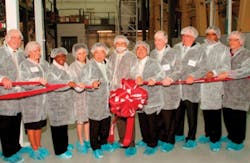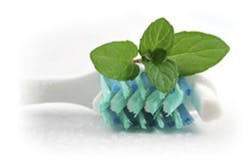Is that barrier really protecting you?
By Ina Pockrass, Co-Founder, Eco-Dentistry Association
Could the common infection control barrier be contributing to the spread of deadly diseases? It turns out the very methods we use to prevent the spread of infectious agents in our operatories may contribute to bringing more deadly diseases to our doorstep.The culprit: single-use disposable products created, packaged, shipped, tossed, and managed-as-waste, for and by dental offices. The Eco-Dentistry Association (EDA) estimates that in the U.S. alone, we dispose of 1.7 billion sterilization pouches and 680 million barriers each year.(1)
Could the common infection control barrier be contributing to the spread of deadly diseases? It turns out the very methods we use to prevent the spread of infectious agents in our operatories may contribute to bringing more deadly diseases to our doorstep.The culprit: single-use disposable products created, packaged, shipped, tossed, and managed-as-waste, for and by dental offices. The Eco-Dentistry Association (EDA) estimates that in the U.S. alone, we dispose of 1.7 billion sterilization pouches and 680 million barriers each year.(1)
Single-use disposables consume energy at every stage. From the extraction of raw materials, to long-term storage in landfills, our disposables rely on fossil fuels and virgin paper which contributes to the excess of carbon dioxide in our atmosphere. According to the Nature Conservancy, more than 56,000 miles of virgin forest are lost every year.(2)
Scientists now say we are reaching a tipping point where global climate change will be irreversible. This year's unseasonably warm weather will not only become the norm, but scientists say we are now on course to create a permanent climate shift.(3) And that means a revision to the menu of diseases we’ll need to consider in our operatories.Just as we experienced an unseasonably warm winter, so did the World Conservation Society’s “Deadly Dozen.” The list includes 12 animal-borne diseases, such as Ebola, plague and cholera, which are likely to spread due to an expanding habitat for their vectors, compliments of global climate change.(4)Earlier spring means a longer tick season, increasing the risk of Lyme disease, also on the “Deadly Dozen” list.(5) Meanwhile, Europe and North America are seeing upticks in tropical and sub-tropical diseases such as dengue fever, tick-borne encephalitis, and West Nile virus. (6)While our infection control processes are designed to keep us safe from pathogens inside the operatory, how can we ensure these same processes don’t support conditions for new pathogens outside our doors?(1) Use only necessary barriers and increase the use of eco-friendly disinfectants. Clean and disinfect light handles, dental chairs, computer keyboards, and operatory surfaces instead of lining the room with plastic. According to OSAP, environmental surfaces “can be managed using less rigorous methods than those used for dental patient-care items.” Clinical contact surfaces only need a barrier if they cannot be effectively cleaned (e.g., digital X-ray sensors). For clinical surfaces that are cleanable, it is perfectly acceptable infection control protocol to forego the barrier, and clean and disinfect between each patient.(7)
Choose an EPA-approved surface disinfectant that cleans and disinfects, and is labeled GRAS (Generally Regarded as Safe). Pay close attention to kill-times, follow manufacturer’s instructions, and ensure surfaces remain wet for the prescribed period. Encourage your dental supplier to offer gloves and masks in sustainable packaging and to consider creating products made of sustainable materials.(2) Choose reusable cloth. Cloth barriers and sterilization pouches are in service in many high-end hospital operatories, but dentistry has been slow to adopt this cost-saving, planet-friendly practice. When items need laundering, choose energy-efficient machines with sterilizing cycles.(3) Rethink the disposables habit. We often choose disposables believing they make our work more efficient. There’s nothing efficient about waste. Lab coats, face shields and many disposable items that fill our trash bin don’t need to be single-use. Just as our patients' oral health is not separate from their bodies, our dental operatories are part of a larger ecosystem. Every time we choose to re-use, in our practices and in our lives, we takes steps to create a safer environment for us all.
References
1. The Eco-Dentistry Association. Dental Office Waste & Pollution. www.ecodentistry.org/.2.The Nature Conservancy. Rainforest Facts. www.nature.org/ourinitiatives/urgentissues/rainforests/rainforests-facts.xml.3. Scientific American “Global Warming Close to Becoming Irreversible,” March 26, 2012. www.scientificamerican.com/article.cfm.4. International News Service.com. “Climate Change Spreads Infectious Disease Worldwide,” January 25, 2011. www.internationalnewsservices.com/articles/1-latest-news/17833-climate-change-spreads-infectious-diseases-worldwide.5. MSPCA.com. Warm Weather Drives Huge Increase in Tick-Borne Diseases in Pets. April 3, 2012. www.mspca.org/about-us/press-room/2012/warm-weather-drives-huge.html.6. International News Service.com. “Climate Change Spreads Infectious Disease Worldwide,” January 25, 2011. www.internationalnewsservices.com/articles/1-latest-news/17833-climate-change-spreads-infectious-diseases-worldwide.7. Organization for Safety & Asepsis Procedures. Infection Control: CDC Guidelines: From Policy to Practice, A Step-by-Step Implementation Workbook. 2004-2007.
1. The Eco-Dentistry Association. Dental Office Waste & Pollution. www.ecodentistry.org/.2.The Nature Conservancy. Rainforest Facts. www.nature.org/ourinitiatives/urgentissues/rainforests/rainforests-facts.xml.3. Scientific American “Global Warming Close to Becoming Irreversible,” March 26, 2012. www.scientificamerican.com/article.cfm.4. International News Service.com. “Climate Change Spreads Infectious Disease Worldwide,” January 25, 2011. www.internationalnewsservices.com/articles/1-latest-news/17833-climate-change-spreads-infectious-diseases-worldwide.5. MSPCA.com. Warm Weather Drives Huge Increase in Tick-Borne Diseases in Pets. April 3, 2012. www.mspca.org/about-us/press-room/2012/warm-weather-drives-huge.html.6. International News Service.com. “Climate Change Spreads Infectious Disease Worldwide,” January 25, 2011. www.internationalnewsservices.com/articles/1-latest-news/17833-climate-change-spreads-infectious-diseases-worldwide.7. Organization for Safety & Asepsis Procedures. Infection Control: CDC Guidelines: From Policy to Practice, A Step-by-Step Implementation Workbook. 2004-2007.
Ina Pockrass is the visionary leader of the green dentistry movement. She has been honored as one of the Top 25 Women in Dentistry and is an attorney and marketing expert. Ina co-created the country’s first green dental office in 2003 and co-founded the Eco-Dentistry Association in 2008. She writes and speaks internationally about green dentistry.





